“Die Zeit ist der schärfste Kritiker des Designs. Ein zeitloses Design überdauert die Moden und Trends und bleibt für die Ewigkeit.”
– Robert Opron
“Se temps est le critique le plus sévère du design. Un design intemporel survit aux modes et aux tendances et reste éternel.”
– Robert Opron
“Time is the harshest critic of design. A timeless design outlasts fashions and trends and remains for eternity.”
– Robert Opron
1990
12.8L / 660kW
129.346 Ex.
Design: Robert Opron
Die späten 1970er Jahre markieren einen entscheidenden Moment in der Karriere von Robert Opron. Seine Arbeit bei Renault führen zu einem der auffälligsten Projekte seiner Laufbahn: dem Design des Renault-Truck Magnum. Dieses Kapitel wirft einen Blick auf die Entstehungsgeschichte dieses beeindruckenden Fahrzeugs und die fruchtbare Kooperation zwischen Robert Opron und Marcello Gandini.
Die Idee für einen neuen Renault LKW entsteht in den späten 1970er Jahren. Im Mai 1977 schlägt Opron dem Direktor der Nutzfahrzeugsparte Renault Vehicules Industriels (RVI), François Zanotti, einen neuen Stil vor, den sein Mitarbeiter Guy Greffier auf Grundlage des ersten Entwurf Oprons verfeinert hat. Doch noch nichts sieht nach einem angestrebten, revolutionären Designkonzept für einen neuen Langstrecken-Lkw aus…
Marcello Gandini, ein angesehener italienischer Automobildesigner, wird von Opron als weiterer Stylist für das Projekt gewonnen. Er bringt eine Fülle von Erfahrung und frischen Ideen mit, um den gewünschten Durchbruch im Nutzfahrzeugdesign zu erzielen.
Gandini und Opron teilen eine langjährige Bekanntschaft und ein tiefes gegenseitiges Respektverhältnis. Ihre gemeinsame Erfahrung im Automobildesign ermöglicht es ihnen, kreative Synergien zu schaffen. Opron, der zuvor bei Citroën für ikonische Modelle wie den Citroën SM und den Citroën GS verantwortlich war, hat eine einzigartige Herangehensweise an das Design von Fahrzeugen. Gandinis Liebe zum futuristischen und bemerkenswert herausragenden Styling drückt sich oft in seinen Arbeiten aus, und das sollte sich auch bei Magnum zeigen.
Die Zusammenarbeit zwischen Opron und Gandini verläuft äußerst reibungslos. Die beiden Designer bringen unterschiedliche Perspektiven und Stile in das Projekt ein, was zu einer gelungenen Fusion führt. Beide Stilrichtungen werden jeweils in einem 1:1 Mockup realisiert.
Robert Opron konzentriert sich auf die Gestaltung des Fahrerhauses und der Vorderpartie des Lkw, wobei er seine Vorliebe für aerodynamische Effizienz einbringt. Die geschwungene Linienführung seines Entwurfs des Magnum sind eindeutige Ergebnisse seiner kreativen Vision.
Marcello Gandini, der für seine Arbeit an Sportwagen wie dem Lamborghini Countach und dem Lancia Stratos bekannt ist, trägt sein Know-how im Umgang mit Proportionen und Linienführung bei. Gandini sorgt in dem von ihmn zwischen September 1981 und Februar 1982 realisierten 1:1-Konzept dafür, dass der Magnum diese Gene übernimmt, und damit nicht nur auffällig, sondern auch funktional und praxistauglich ist. Seine Erfahrung im Design von Sportwagen bringt eine dynamische Eleganz in das Nutzfahrzeugsegment, die zuvor unerreicht ist.
Das Fahrerhaus ist vom Motorraum räumlich komplett getrennt und erhält einen ebenen Boden, in den kein Motortunnel mehr hereinragt. Optisch wird das Fahrerhaus deutlich vom restlichen Fahrzeug getrennt. Der Aufstieg in das für damalige Verhältnisse sehr hoch bauende Fahrerhaus ist hinter der Vorderachse und nicht wie sonst üblich davor.
Am 14. April 1982 werden beide Entwürfe auf dem amerikanischen Luftwaffen-Stützpunkt Crucey (Eure-et-Loire) zusammen mit den Modellen der Konkurrenz (Volvo, Scania, DAF, Ford) und anderen Renault-Modellen präsentiert. Das fast schon brutale Design Gandinis wird weiter entwickelt und zur Produktionsreife gebracht.
Das Designprojekt Magnum ist eine aufregende und fruchtbare Phase in der Karriere von Robert Opron. Er kann seine Leidenschaft für avantgardistische Formen und sein Talent für innovative Konzepte voll zum Ausdruck bringen. Die Zusammenarbeit mit Marcello Gandini erweitert seinen Horizont und führt zu einem bemerkenswerten Ergebnis.
Der Renault-Truck Magnum wird schließlich im Jahr 1990 auf den Markt gebracht und erregt sofort großes Aufsehen. Mit seinem futuristischen Design, der markanten Linienführung und der Funktionalität, die den Anforderungen der Langstrecken- und Fernverkehrsbranche gerecht wird, setzt er neue Maßstäbe im Nutzfahrzeugdesign. Die gemeinsame Arbeit von Robert Opron und Marcello Gandini trägt entscheidend dazu bei, den Magnum zu einem Symbol für Innovation und Eleganz auf den Straßen Europas zu machen. Erst 2013 wird die Produktion eingestellt.
La fin des années 1970 marque un moment décisif dans la carrière de Robert Opron. Son travail chez Renault le conduit vers l’un des projets les plus marquants de sa carrière : la conception du Renault Truck Magnum. Ce chapitre se penche sur l’origine de ce véhicule impressionnant et la collaboration fructueuse entre Robert Opron et Marcello Gandini.
L’idée d’un nouveau camion Renault émerge à la fin des années 1970. En mai 1977, Opron présente un nouveau style à François Zanotti, le directeur de Renault Vehicules Industriels (RVI), basé sur la conception initiale que son collègue, Guy Greffier, avait affinée. Cependant, rien ne ressemble encore au concept de design révolutionnaire souhaité pour un camion longue distance…
Marcello Gandini, un célèbre designer automobile italien, est recruté par Opron en tant que styliste supplémentaire pour le projet. Il apporte une riche expérience et des idées fraîches pour réaliser la percée souhaitée dans la conception de véhicules utilitaires.
Gandini et Opron partagent une longue connaissance mutuelle et un profond respect réciproque. Leur expérience combinée dans la conception automobile leur permet de créer des synergies créatives. Opron, précédemment responsable de modèles emblématiques comme la Citroën SM et la Citroën GS chez Citroën, a une approche unique de la conception de véhicules. L’amour de Gandini pour un style futuriste et remarquablement distinct se manifeste souvent dans son travail, et il est évident dans le projet Magnum.
La collaboration entre Opron et Gandini se déroule très facilement. Les deux designers apportent des perspectives et des styles différents au projet, résultant en une fusion réussie. Les deux styles sont réalisés dans une maquette à l’échelle 1:1.
Robert Opron se concentre sur la conception de la cabine et de l’avant du camion, intégrant sa préférence pour l’efficacité aérodynamique. Les lignes sinueuses de sa conception du Magnum sont des manifestations claires de sa vision créative.
Marcello Gandini, connu pour son travail sur des voitures de sport comme la Lamborghini Countach et la Lancia Stratos, apporte son expertise en matière de proportions et de lignes. Dans le concept 1:1 réalisé par lui entre septembre 1981 et février 1982, Gandini veille à ce que le Magnum hérite de ces gènes, en faisant non seulement un objet attirant le regard, mais aussi fonctionnel et pratique. Son expérience dans la conception de voitures de sport introduit une élégance dynamique dans le segment des véhicules utilitaires, précédemment inégalée.
La cabine est spatialement séparée du compartiment moteur et présente un plancher plat sans tunnel moteur saillant. Visuellement, la cabine se distingue du reste du véhicule. L’entrée dans la cabine, relativement haute selon les normes de l’époque, est située derrière l’essieu avant, contrairement à la pratique habituelle qui la place devant.
Le 14 avril 1982, les deux conceptions, ainsi que les modèles des concurrents (Volvo, Scania, DAF, Ford) et d’autres modèles Renault, sont présentés sur la base aérienne américaine de Crucey, en Eure-et-Loire. Le design presque brutal de Gandini est ensuite affiné et préparé pour la production.
Le projet de conception du Magnum est une phase excitante et fructueuse de la carrière de Robert Opron. Il lui permet d’exprimer sa passion pour les formes avant-gardistes et son talent pour des concepts innovants. La collaboration avec Marcello Gandini élargit ses horizons et conduit à un résultat remarquable.
Le Renault Truck Magnum est finalement introduit sur le marché en 1990, attirant immédiatement une grande attention. Avec son design futuriste, ses lignes distinctives et sa fonctionnalité répondant aux exigences du transport longue distance et du fret, il établit de nouvelles normes en matière de conception de véhicules utilitaires. Le travail collaboratif de Robert Opron et Marcello Gandini contribue de manière significative à faire du Magnum un symbole d’innovation et d’élégance sur les routes européennes. La production cesse seulement en 2013.
The idea for a new Renault truck emerges in the late 1970s. In May 1977, Opron presents a new style to François Zanotti, the director of Renault Vehicules Industriels (RVI), based on the initial design that his colleague, Guy Greffier, had refined. However, nothing yet resembles the desired revolutionary design concept for a long-haul truck…
Marcello Gandini, a renowned Italian automotive designer, is enlisted by Opron as an additional stylist for the project. He brings a wealth of experience and fresh ideas to achieve the desired breakthrough in commercial vehicle design.
Gandini and Opron share a long-standing acquaintance and deep mutual respect. Their combined experience in automotive design allows them to create creative synergies. Opron, previously responsible for iconic models like the Citroën SM and Citroën GS at Citroën, has a unique approach to vehicle design. Gandini’s love for futuristic and remarkably outstanding styling often manifests in his work, and it is evident in the Magnum project.
The collaboration between Opron and Gandini proceeds very smoothly. Both designers bring different perspectives and styles to the project, resulting in a successful fusion. Both styles are realized in a 1:1 mockup.
Robert Opron focuses on designing the cab and the front of the truck, incorporating his preference for aerodynamic efficiency. The curvaceous lines of his Magnum design are clear manifestations of his creative vision.
Marcello Gandini, known for his work on sports cars like the Lamborghini Countach and the Lancia Stratos, brings his expertise in proportions and lines. In the 1:1 concept realized by him between September 1981 and February 1982, Gandini ensures that the Magnum inherits these genes, making it not only eye-catching but also functional and practical. His experience in sports car design introduces dynamic elegance into the commercial vehicle segment, previously unattained.
The cab is spatially separated from the engine compartment and features a flat floor with no engine tunnel protruding. Visually, the cab is distinct from the rest of the vehicle. The entry into the relatively high cab, by the standards of that time, is located behind the front axle, unlike the usual practice of placing it in front.
On April 14, 1982, both designs, along with models from competitors (Volvo, Scania, DAF, Ford), and other Renault models, are presented at the Crucey U.S. Air Force Base in Eure-et-Loire. Gandini’s almost brutal design is further developed and brought to production readiness.
The Magnum design project is an exciting and fruitful phase in Robert Opron’s career. It allows him to express his passion for avant-garde forms and his talent for innovative concepts. The collaboration with Marcello Gandini broadens his horizons and leads to a remarkable result.
The Renault Truck Magnum is eventually introduced to the market in 1990, immediately attracting significant attention. With its futuristic design, distinctive lines, and functionality meeting the demands of long-haul and freight transport, it sets new standards in commercial vehicle design. The collaborative work of Robert Opron and Marcello Gandini significantly contributes to making the Magnum a symbol of innovation and elegance on European roads. Production only ceases in 2013.
1990
12.8L / 660kW
129.346 Ex.
Design: Robert Opron
Die späten 1970er Jahre markieren einen entscheidenden Moment in der Karriere von Robert Opron. Seine Arbeit bei Renault führen zu einem der auffälligsten Projekte seiner Laufbahn: dem Design des Renault-Truck Magnum. Dieses Kapitel wirft einen Blick auf die Entstehungsgeschichte dieses beeindruckenden Fahrzeugs und die fruchtbare Kooperation zwischen Robert Opron und Marcello Gandini.
Die Idee für einen neuen Renault LKW entsteht in den späten 1970er Jahren. Im Mai 1977 schlägt Opron dem Direktor der Nutzfahrzeugsparte Renault Vehicules Industriels (RVI), François Zanotti, einen neuen Stil vor, den sein Mitarbeiter Guy Greffier auf Grundlage des ersten Entwurf Oprons verfeinert hat. Doch noch nichts sieht nach einem angestrebten, revolutionären Designkonzept für einen neuen Langstrecken-Lkw aus…
Marcello Gandini, ein angesehener italienischer Automobildesigner, wird von Opron als weiterer Stylist für das Projekt gewonnen. Er bringt eine Fülle von Erfahrung und frischen Ideen mit, um den gewünschten Durchbruch im Nutzfahrzeugdesign zu erzielen.
Gandini und Opron teilen eine langjährige Bekanntschaft und ein tiefes gegenseitiges Respektverhältnis. Ihre gemeinsame Erfahrung im Automobildesign ermöglicht es ihnen, kreative Synergien zu schaffen. Opron, der zuvor bei Citroën für ikonische Modelle wie den Citroën SM und den Citroën GS verantwortlich war, hat eine einzigartige Herangehensweise an das Design von Fahrzeugen. Gandinis Liebe zum futuristischen und bemerkenswert herausragenden Styling drückt sich oft in seinen Arbeiten aus, und das sollte sich auch bei Magnum zeigen.
Die Zusammenarbeit zwischen Opron und Gandini verläuft äußerst reibungslos. Die beiden Designer bringen unterschiedliche Perspektiven und Stile in das Projekt ein, was zu einer gelungenen Fusion führt. Beide Stilrichtungen werden jeweils in einem 1:1 Mockup realisiert.
Robert Opron konzentriert sich auf die Gestaltung des Fahrerhauses und der Vorderpartie des Lkw, wobei er seine Vorliebe für aerodynamische Effizienz einbringt. Die geschwungene Linienführung seines Entwurfs des Magnum sind eindeutige Ergebnisse seiner kreativen Vision.
Marcello Gandini, der für seine Arbeit an Sportwagen wie dem Lamborghini Countach und dem Lancia Stratos bekannt ist, trägt sein Know-how im Umgang mit Proportionen und Linienführung bei. Gandini sorgt in dem von ihmn zwischen September 1981 und Februar 1982 realisierten 1:1-Konzept dafür, dass der Magnum diese Gene übernimmt, und damit nicht nur auffällig, sondern auch funktional und praxistauglich ist. Seine Erfahrung im Design von Sportwagen bringt eine dynamische Eleganz in das Nutzfahrzeugsegment, die zuvor unerreicht ist.
Das Fahrerhaus ist vom Motorraum räumlich komplett getrennt und erhält einen ebenen Boden, in den kein Motortunnel mehr hereinragt. Optisch wird das Fahrerhaus deutlich vom restlichen Fahrzeug getrennt. Der Aufstieg in das für damalige Verhältnisse sehr hoch bauende Fahrerhaus ist hinter der Vorderachse und nicht wie sonst üblich davor.
Am 14. April 1982 werden beide Entwürfe auf dem amerikanischen Luftwaffen-Stützpunkt Crucey (Eure-et-Loire) zusammen mit den Modellen der Konkurrenz (Volvo, Scania, DAF, Ford) und anderen Renault-Modellen präsentiert. Das fast schon brutale Design Gandinis wird weiter entwickelt und zur Produktionsreife gebracht.
Das Designprojekt Magnum ist eine aufregende und fruchtbare Phase in der Karriere von Robert Opron. Er kann seine Leidenschaft für avantgardistische Formen und sein Talent für innovative Konzepte voll zum Ausdruck bringen. Die Zusammenarbeit mit Marcello Gandini erweitert seinen Horizont und führt zu einem bemerkenswerten Ergebnis.
Der Renault-Truck Magnum wird schließlich im Jahr 1990 auf den Markt gebracht und erregt sofort großes Aufsehen. Mit seinem futuristischen Design, der markanten Linienführung und der Funktionalität, die den Anforderungen der Langstrecken- und Fernverkehrsbranche gerecht wird, setzt er neue Maßstäbe im Nutzfahrzeugdesign. Die gemeinsame Arbeit von Robert Opron und Marcello Gandini trägt entscheidend dazu bei, den Magnum zu einem Symbol für Innovation und Eleganz auf den Straßen Europas zu machen. Erst 2013 wird die Produktion eingestellt.
La fin des années 1970 marque un moment décisif dans la carrière de Robert Opron. Son travail chez Renault le conduit vers l’un des projets les plus marquants de sa carrière : la conception du Renault Truck Magnum. Ce chapitre se penche sur l’origine de ce véhicule impressionnant et la collaboration fructueuse entre Robert Opron et Marcello Gandini.
L’idée d’un nouveau camion Renault émerge à la fin des années 1970. En mai 1977, Opron présente un nouveau style à François Zanotti, le directeur de Renault Vehicules Industriels (RVI), basé sur la conception initiale que son collègue, Guy Greffier, avait affinée. Cependant, rien ne ressemble encore au concept de design révolutionnaire souhaité pour un camion longue distance…
Marcello Gandini, un célèbre designer automobile italien, est recruté par Opron en tant que styliste supplémentaire pour le projet. Il apporte une riche expérience et des idées fraîches pour réaliser la percée souhaitée dans la conception de véhicules utilitaires.
Gandini et Opron partagent une longue connaissance mutuelle et un profond respect réciproque. Leur expérience combinée dans la conception automobile leur permet de créer des synergies créatives. Opron, précédemment responsable de modèles emblématiques comme la Citroën SM et la Citroën GS chez Citroën, a une approche unique de la conception de véhicules. L’amour de Gandini pour un style futuriste et remarquablement distinct se manifeste souvent dans son travail, et il est évident dans le projet Magnum.
La collaboration entre Opron et Gandini se déroule très facilement. Les deux designers apportent des perspectives et des styles différents au projet, résultant en une fusion réussie. Les deux styles sont réalisés dans une maquette à l’échelle 1:1.
Robert Opron se concentre sur la conception de la cabine et de l’avant du camion, intégrant sa préférence pour l’efficacité aérodynamique. Les lignes sinueuses de sa conception du Magnum sont des manifestations claires de sa vision créative.
Marcello Gandini, connu pour son travail sur des voitures de sport comme la Lamborghini Countach et la Lancia Stratos, apporte son expertise en matière de proportions et de lignes. Dans le concept 1:1 réalisé par lui entre septembre 1981 et février 1982, Gandini veille à ce que le Magnum hérite de ces gènes, en faisant non seulement un objet attirant le regard, mais aussi fonctionnel et pratique. Son expérience dans la conception de voitures de sport introduit une élégance dynamique dans le segment des véhicules utilitaires, précédemment inégalée.
La cabine est spatialement séparée du compartiment moteur et présente un plancher plat sans tunnel moteur saillant. Visuellement, la cabine se distingue du reste du véhicule. L’entrée dans la cabine, relativement haute selon les normes de l’époque, est située derrière l’essieu avant, contrairement à la pratique habituelle qui la place devant.
Le 14 avril 1982, les deux conceptions, ainsi que les modèles des concurrents (Volvo, Scania, DAF, Ford) et d’autres modèles Renault, sont présentés sur la base aérienne américaine de Crucey, en Eure-et-Loire. Le design presque brutal de Gandini est ensuite affiné et préparé pour la production.
Le projet de conception du Magnum est une phase excitante et fructueuse de la carrière de Robert Opron. Il lui permet d’exprimer sa passion pour les formes avant-gardistes et son talent pour des concepts innovants. La collaboration avec Marcello Gandini élargit ses horizons et conduit à un résultat remarquable.
Le Renault Truck Magnum est finalement introduit sur le marché en 1990, attirant immédiatement une grande attention. Avec son design futuriste, ses lignes distinctives et sa fonctionnalité répondant aux exigences du transport longue distance et du fret, il établit de nouvelles normes en matière de conception de véhicules utilitaires. Le travail collaboratif de Robert Opron et Marcello Gandini contribue de manière significative à faire du Magnum un symbole d’innovation et d’élégance sur les routes européennes. La production cesse seulement en 2013.
The late 1970s mark a pivotal moment in the career of Robert Opron. His work at Renault leads to one of the most striking projects of his career: the design of the Renault Truck Magnum. This chapter takes a closer look at the origin of this impressive vehicle and the fruitful collaboration between Robert Opron and Marcello Gandini.
The idea for a new Renault truck emerges in the late 1970s. In May 1977, Opron presents a new style to François Zanotti, the director of Renault Vehicules Industriels (RVI), based on the initial design that his colleague, Guy Greffier, had refined. However, nothing yet resembles the desired revolutionary design concept for a long-haul truck…
Marcello Gandini, a renowned Italian automotive designer, is enlisted by Opron as an additional stylist for the project. He brings a wealth of experience and fresh ideas to achieve the desired breakthrough in commercial vehicle design.
Gandini and Opron share a long-standing acquaintance and deep mutual respect. Their combined experience in automotive design allows them to create creative synergies. Opron, previously responsible for iconic models like the Citroën SM and Citroën GS at Citroën, has a unique approach to vehicle design. Gandini’s love for futuristic and remarkably outstanding styling often manifests in his work, and it is evident in the Magnum project.
The collaboration between Opron and Gandini proceeds very smoothly. Both designers bring different perspectives and styles to the project, resulting in a successful fusion. Both styles are realized in a 1:1 mockup.
Robert Opron focuses on designing the cab and the front of the truck, incorporating his preference for aerodynamic efficiency. The curvaceous lines of his Magnum design are clear manifestations of his creative vision.
Marcello Gandini, known for his work on sports cars like the Lamborghini Countach and the Lancia Stratos, brings his expertise in proportions and lines. In the 1:1 concept realized by him between September 1981 and February 1982, Gandini ensures that the Magnum inherits these genes, making it not only eye-catching but also functional and practical. His experience in sports car design introduces dynamic elegance into the commercial vehicle segment, previously unattained.
The cab is spatially separated from the engine compartment and features a flat floor with no engine tunnel protruding. Visually, the cab is distinct from the rest of the vehicle. The entry into the relatively high cab, by the standards of that time, is located behind the front axle, unlike the usual practice of placing it in front.
On April 14, 1982, both designs, along with models from competitors (Volvo, Scania, DAF, Ford), and other Renault models, are presented at the Crucey U.S. Air Force Base in Eure-et-Loire. Gandini’s almost brutal design is further developed and brought to production readiness.
The Magnum design project is an exciting and fruitful phase in Robert Opron’s career. It allows him to express his passion for avant-garde forms and his talent for innovative concepts. The collaboration with Marcello Gandini broadens his horizons and leads to a remarkable result.
The Renault Truck Magnum is eventually introduced to the market in 1990, immediately attracting significant attention. With its futuristic design, distinctive lines, and functionality meeting the demands of long-haul and freight transport, it sets new standards in commercial vehicle design. The collaborative work of Robert Opron and Marcello Gandini significantly contributes to making the Magnum a symbol of innovation and elegance on European roads. Production only ceases in 2013.

Renault Magnum
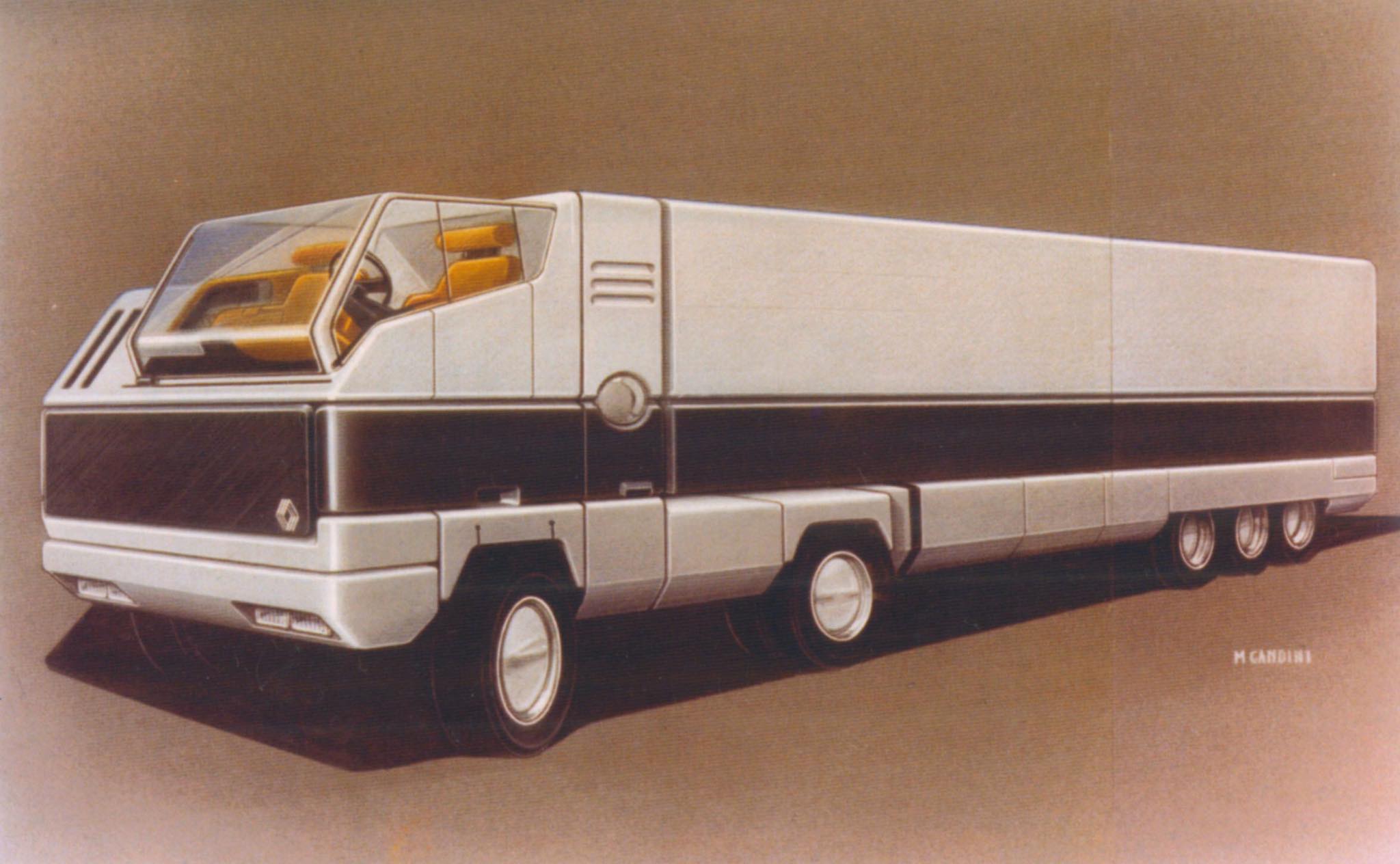
Renault Magnum, Concept M. Gandini
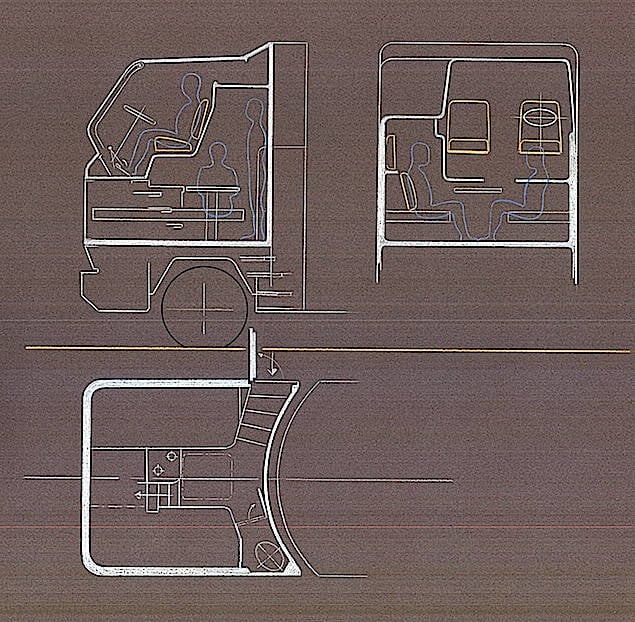
Renault Magnum, Concept M. Gandini

Renault Magnum, Concept M. Gandini
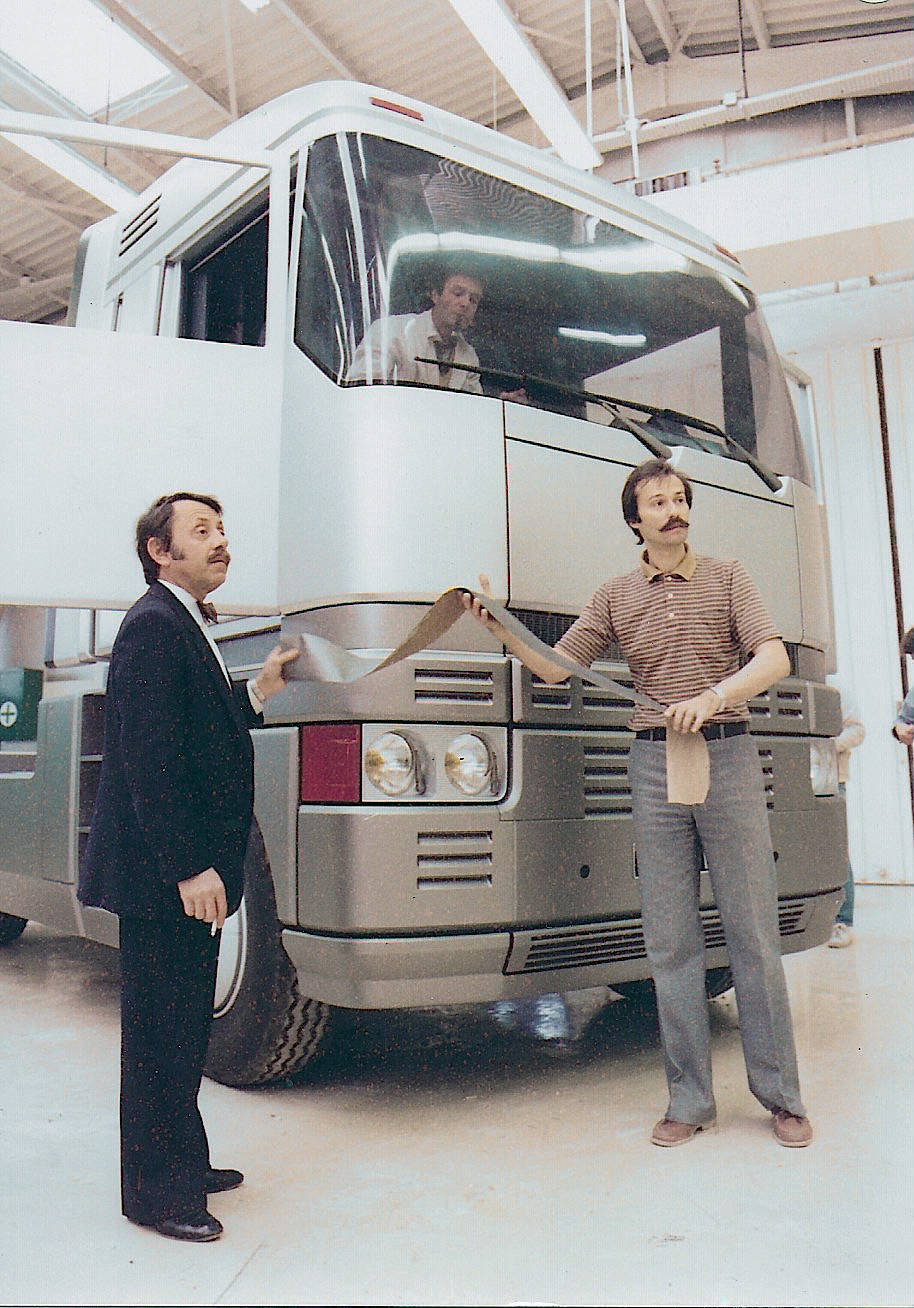
Renault Magnum, Design Robert Opron

Renault Magnum, Design Robert Opron
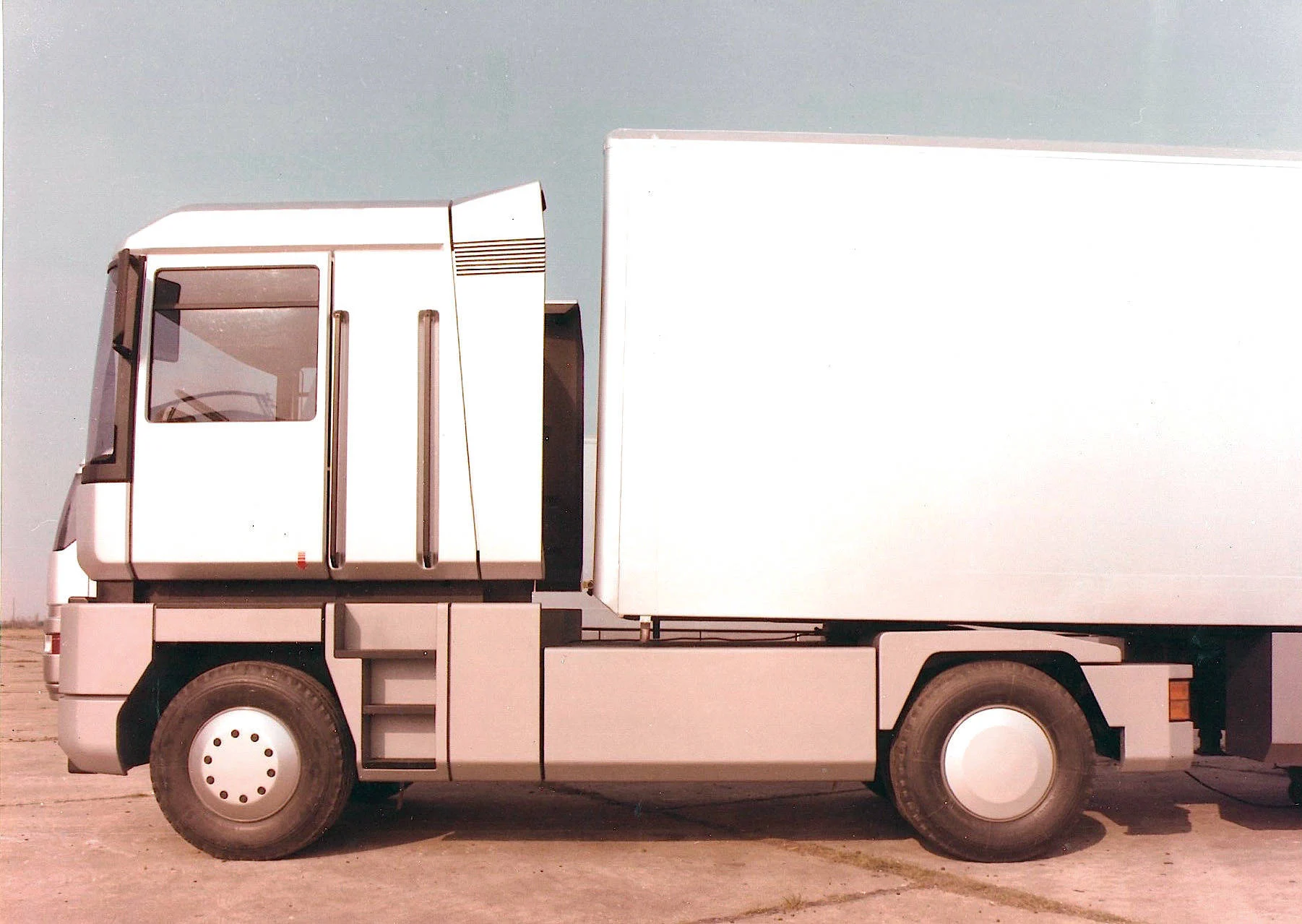
Renault Magnum, Design M. Gandini
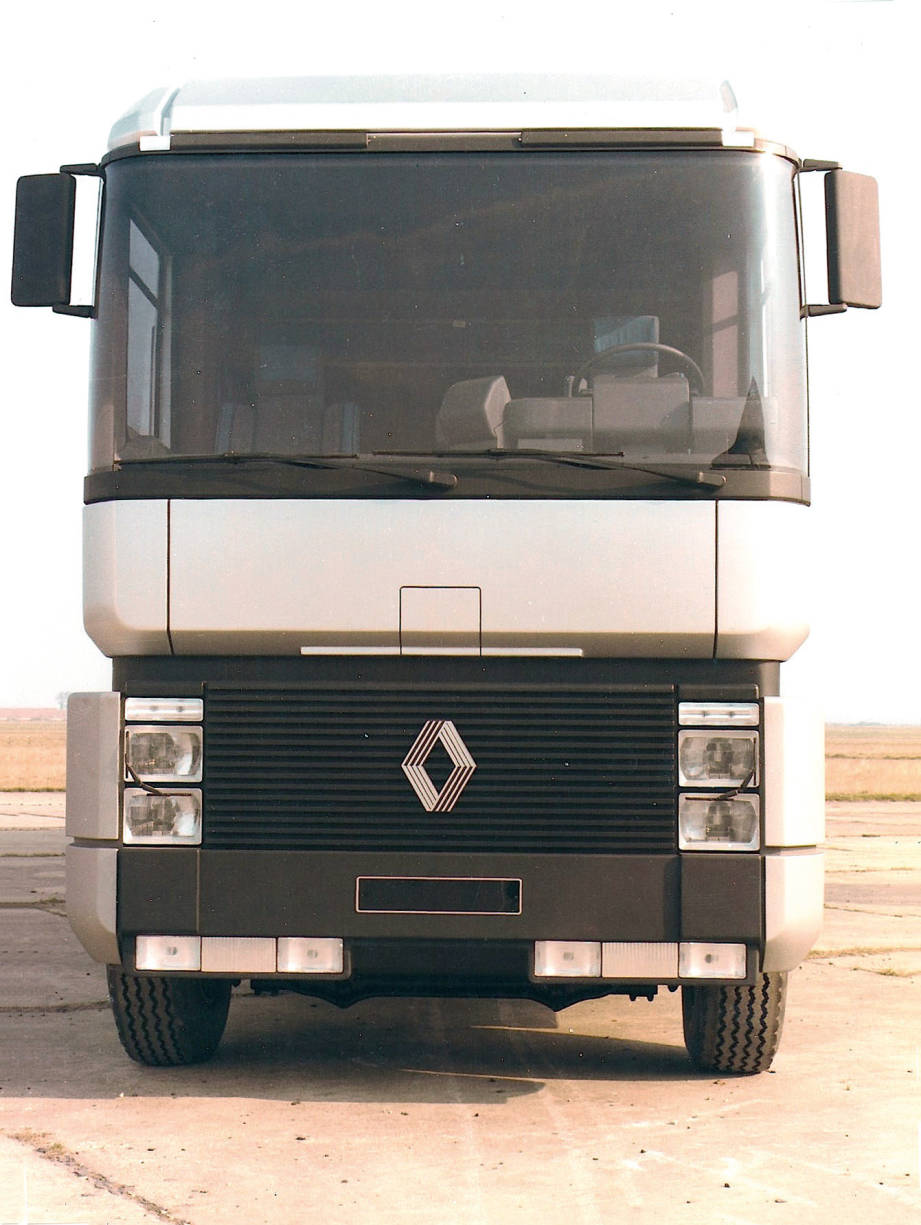
Renault Magnum, Design M. Gandini
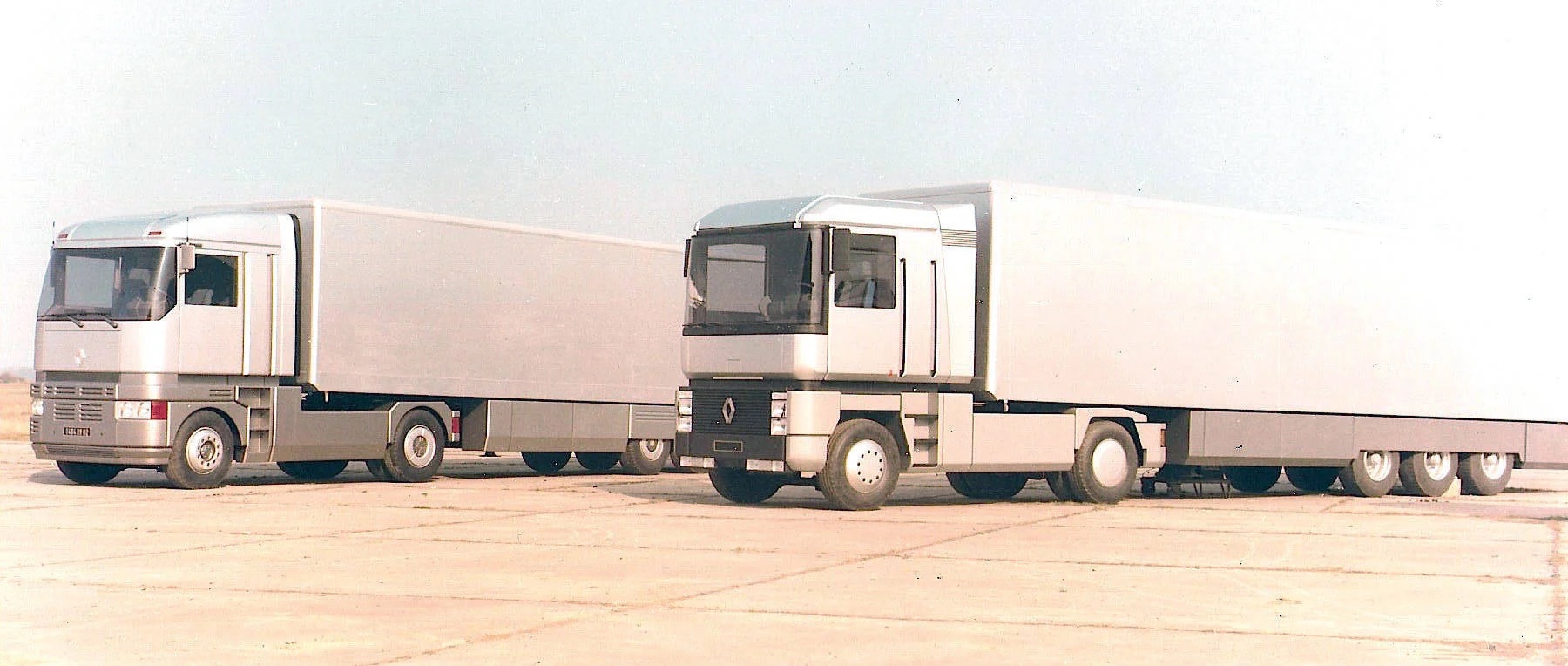
Renault Magnum, Style Opron & Style Gandini
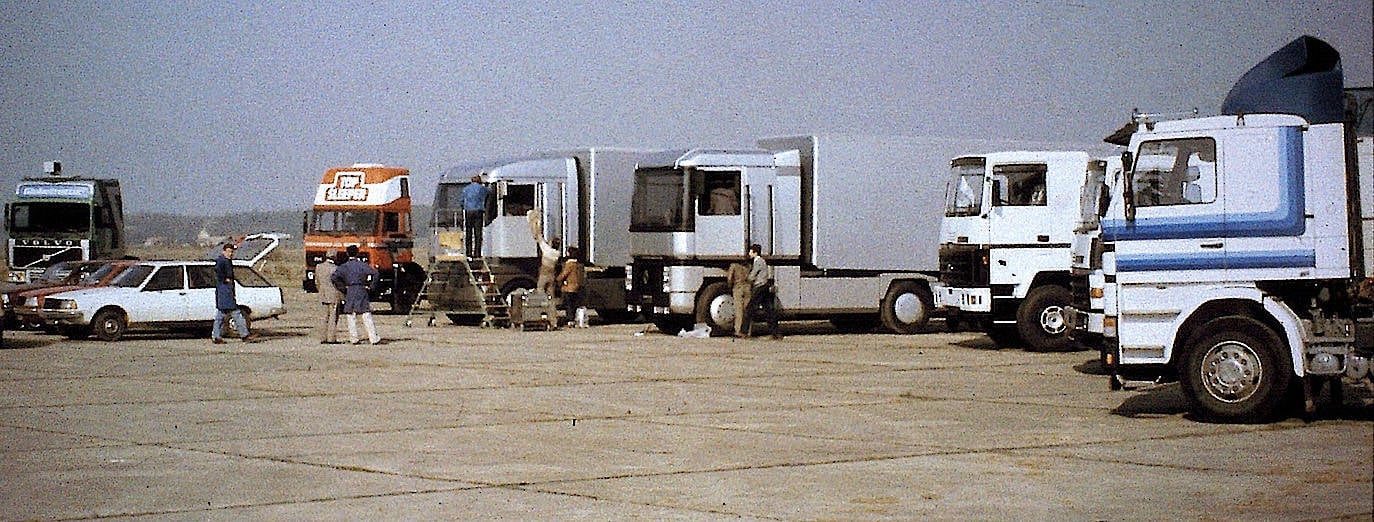
Renault Magnum, Style Opron/Gandini, 04/1982
Photos: Renault Presse
